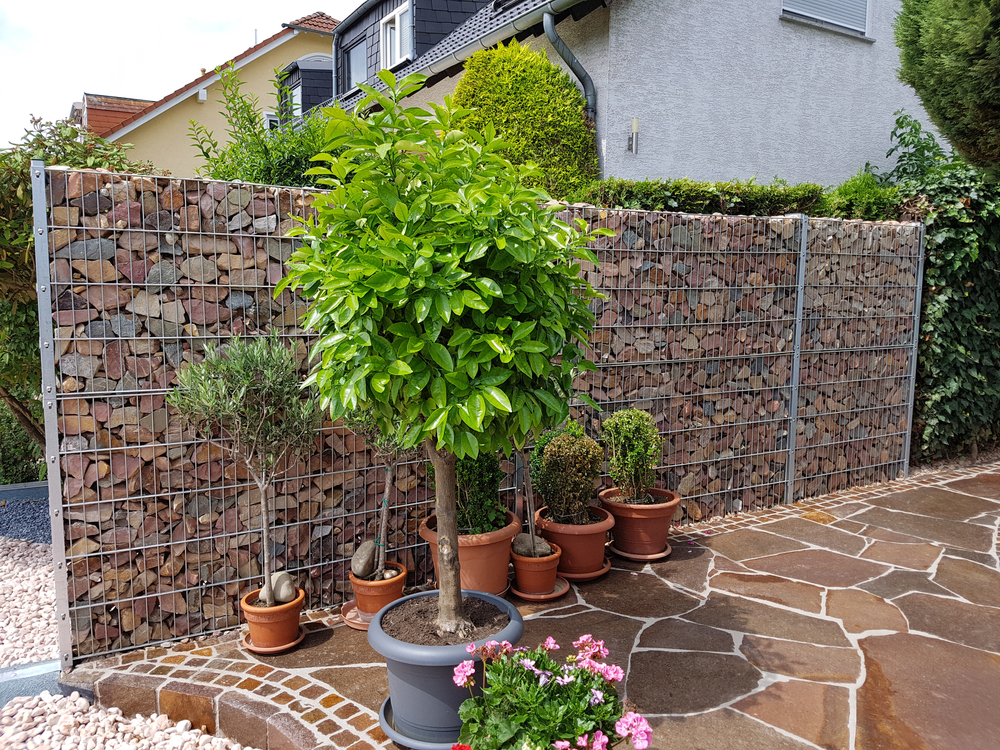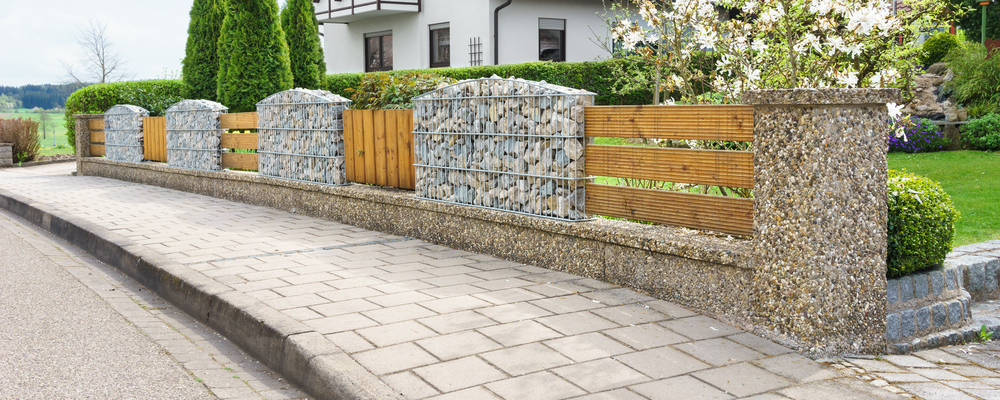Gabion fences, also referred to as Gabion walls, are a simple, beautiful way to create a barrier, bench, or garden enclosure for your space. Constructing them requires little expertise, making it one of the better options for fencing and increasing curb appeal for the average homeowner.
Table of Contents
Comparison: Gabion Fences vs. Wooden Fencing
Gabion fences are notable for their sturdiness and earthy appeal. In the simplest of terms, a Gabion fence is a wall made of rocks, stones, and other materials held together by a wire cage.
A wooden fence, in comparison, certainly does not appear the same. Where a wooden fence is composed of slats of wood placed parallel to one another, the Gabion fence is a larger structure made of rocks contained in a wire cage.
How do you make a gabion fence?
As fences are more of an undertaking than smaller gabion baskets, their construction is slightly more complex. If you’re constructing a gabion fence, ensure that it is constructed approximately 500mm below ground to allow for any future excavation work should it be required. Using a hoe or flat shovel is the best way to remove any grass or topsoil that may interfere with installation. Though you needn’t have a foundation for gabion walls (much like other gabion structures), you should place your fence on solid footing, and remove all organic matter that has the potential to decay.
If you’re creating a linked gabion fence, it’s advisable to know how many panels you require. As many gabions come flat-packed and linked with stainless steel clips, they are relatively easy to join. If you’re constructing your own gabion fence without professional help, you would be well-advised to purchase some helicoils (long springs that wind down the corner of the individual baskets). These attach to the front and side panels of a basket and make the final assembly job much easier. If you are hiring a contractor, taking these steps will significantly reduce your installation costs, so it is certainly worth looking into.

As with any other gabion structure, selecting the right filler is crucial to the level of retention that it can provide. Quarried stone is usually preferred for fences, as they have the best interlocking characteristics that retain their integrity across multiple baskets. When packing your gabion baskets to create a fence, ensure that the rock fill is tightly packed and that lace all wire corners have a continual seam. Not only will this be more aesthetically pleasing, but it will be much more structurally sound.
Are gabion fences expensive?
When choosing to build a retaining structure, cost is an obvious consideration. Though they’re not cheap per se, they’re certainly more cost-effective than using concrete slabs. As well as this, the cost of gabions tends to spread over a longer period. With little maintenance required if the steel used has been properly galvanized, they are long-term solutions that should pay dividends.
In addition, as they’re quick to construct, you can save considerable amounts of cash on man-hours that add up over time. As they don’t need professional contractors to install, they are, overall, far more inexpensive endeavors than the alternatives available.

The cost of constructing a Gabion fence can vary greatly depending on the materials used and who supplies them. Gabion baskets or caging is often sold at an industry standard of three-foot increments. Assuming that you take the normal route and opt for your wire made of galvanized steel, you could expect prices to be as low as twenty-five dollars per increment.
Choosing the rocks and stones to place in the gabion will also affect the cost of installation. Depending on the rock type you prefer, you could be looking anywhere from twenty-five to sixty dollars or more for your crushed stone.
Is gabion fencing retaining?
Due to the nature of gabions, they tend to be very good retainers. As they’re designed to counteract the force of the ground’s load, the stacking process involved with creating these fences make them useful retainers. Unlike blocks of concrete or other retaining options, gabion walls can be set-up in any alignment due to the flexibility of the materials used.
Finally, gabions are far less prone to undermining, and can move with the earth to retain their integrity in natural conditions. Therefore, a gabion fence is an effective long-term retaining option, as its porous structure ensures that soil particles can gradually reinforce the fence’s initial strength, giving you more bang for your buck.
DIY: Building a Gabion Fence Yourself
Gabion fences are wonderful for those who prefer a DIY route. They’re straightforward to install and do not require an excessive amount of labor and equipment.
What Materials You Need
As far as materials go, you won’t need anything too fancy. Work gloves, pliers, heavy-duty wire cutters, a level, hammer, and wheelbarrow should cover your needs.
Additional tools and materials may be needed for your fencing, depending on the quality of the ground you’re working with. Other materials include:
- Landscaping fabric
- A shovel
- String and pegs (for measuring)
- Gravel
- Supporting posts
- Concrete
- Panel dividers
How to Build a Gabion Fence
Below are the steps necessary to take when constructing your Gabion fence.
Make a Layout
First, you need to create a site layout. You want your fencing to be as appealing as possible, so this is an important step. A great way to do this is to use string and pegs to mark your Gabion wall’s location. Use the string and a level to ensure everything is straight. After all, you don’t want a leaning fence.
Prep the Foundation
When prepping the foundation, the first thing you should do is level the soil. Use a shovel to smooth out any mounds or fill in gaps. A level base will greatly affect the structure of your Gabion fence. Following this step, place landscaping fabric down to prevent weeds, grass, and other plants from growing in your Gabion wall.
If the ground where you plan to place your fence is sandy or soft, you can always add a layer of gravel on top of the landscaping fabric to offer more support and prevent your wall from sinking into the ground over time. The gravel layer should not be taller than six inches.
Add Supports
Depending on the height and width of your Gabion wall, as well as the type of soil in your area, you may need to add supports to ensure maximum stability. While there is no set limit on when you need to add support beams, you should consider this an option when planning your initial design.
If you use support posts, you can opt for a simple metal beam buried at least three or four feet underground and held in place using concrete. While this process is easy to do, it’s up to you to decide if it is a necessary step.
Assemble the Wire Baskets
You’ll want to assemble your wire basket and then place it in the designated locations to create your Gabion wall structure. Most wire baskets come with a painless process of weaving the mesh to the appropriate coils. In modern systems of Gabion wiring, the spiraled connectors arrive with the entire kit.
Once the wiring is connected, clip off the excess and begin placing your baskets in their locations. You can also utilize supporting division panels between each basket for additional security. The height and width of your wire baskets should not exceed three feet either way. Of course, once you fill the base layer with rocks, you can begin attaching the upper-level baskets.
Add Your Stones
Adding your stones is perhaps the easiest step. A great practice is to add your larger stones first and place them at the base and facing the outer wall. Then, fill in the gaps with smaller stones and gravel. This is the quickest installation method and often results in the most appealing Gabion walls as the larger stones look stunning from the outside.
Level the Top
To finalize your Gabion fence’s construction, you should use a level on top of each three-foot section of your structure to ensure that it is flat and level. You don’t want a crooked or bulky looking wall. A level will highlight any trouble areas, and you can adjust them as need be.
Final Touches
To finish up, spray down your Gabion fence with a hose. This helps clear out any excess dust and debris to accentuate the beauty of your new Gabion fence. People also like to lay down strips of landscaping fabric and some gravel around their wall’s base for an interesting effect, to eliminate the chance that weeds will try to grow up into your wall.
Suppliers
If you’re looking for some reliable suppliers for Gabion fencing, we’ve found some great options below.
Where Can you Buy Gabion Fencing from Online?
Gabion Supply is a wonderful online retailer for Gabion fencing products. They sell a range of posts, rocks, and wireframes in various shapes, sizes, and colors. If you’re not sure where to start, Gabion Supply is a great option.

